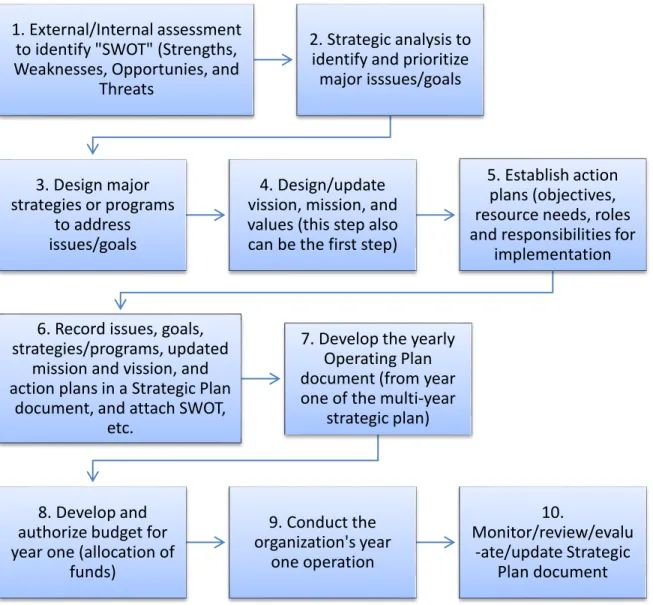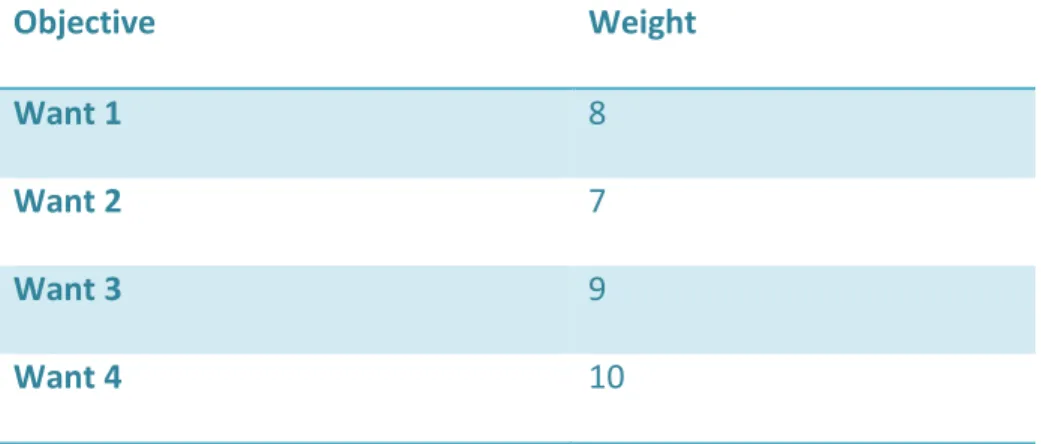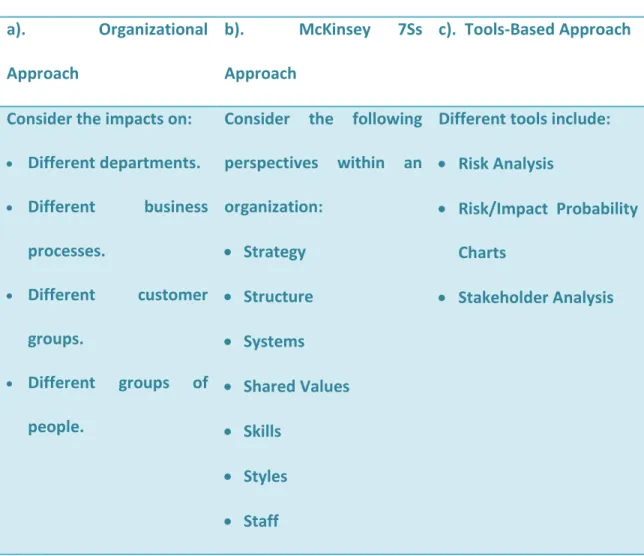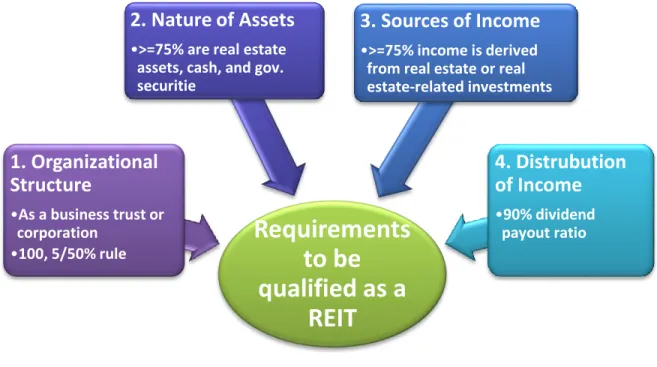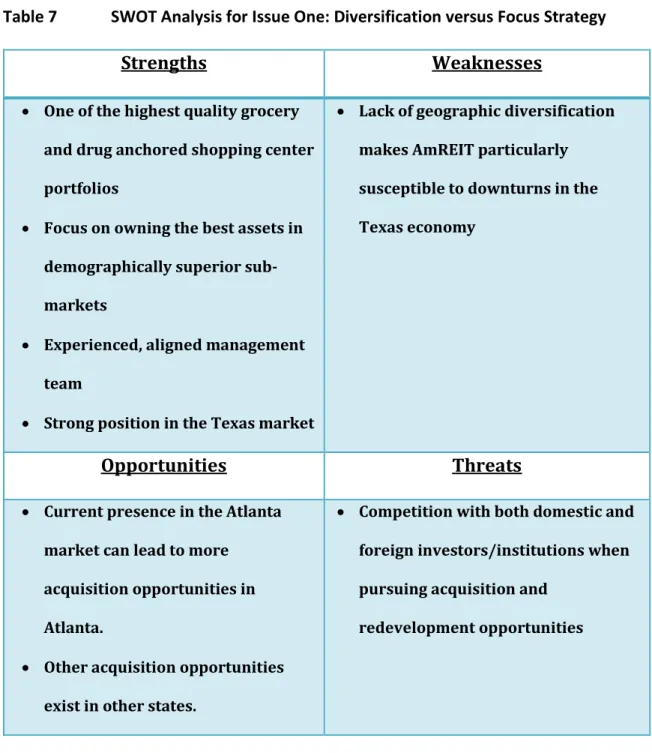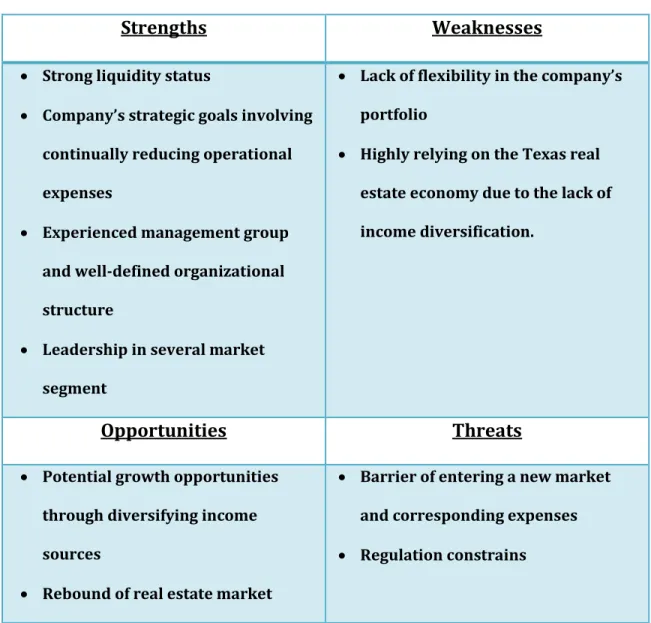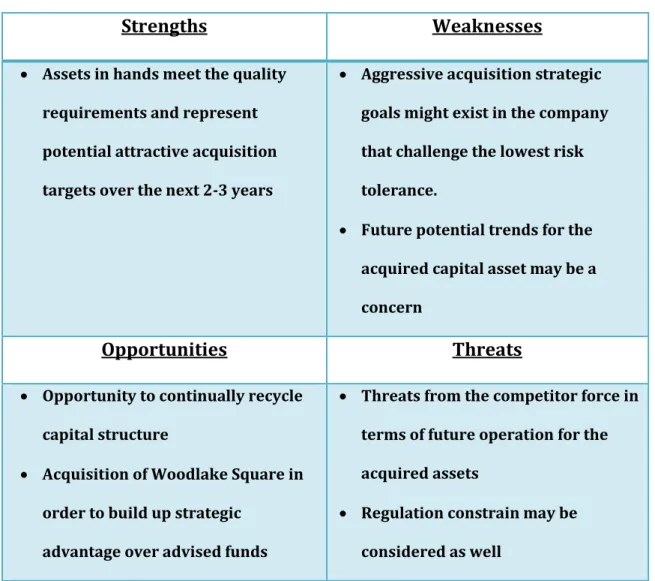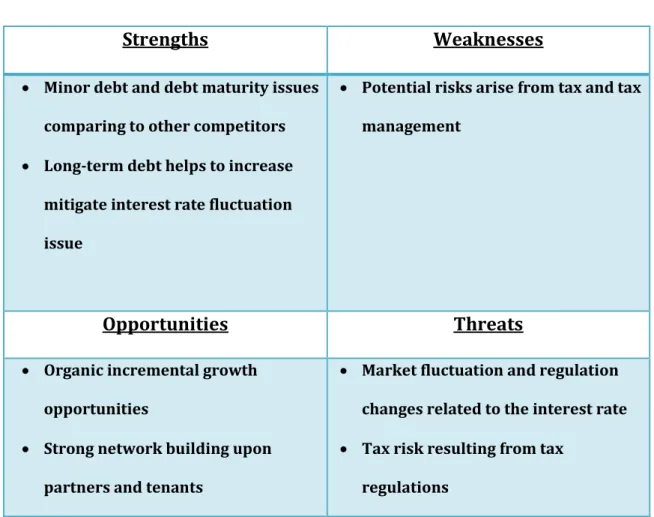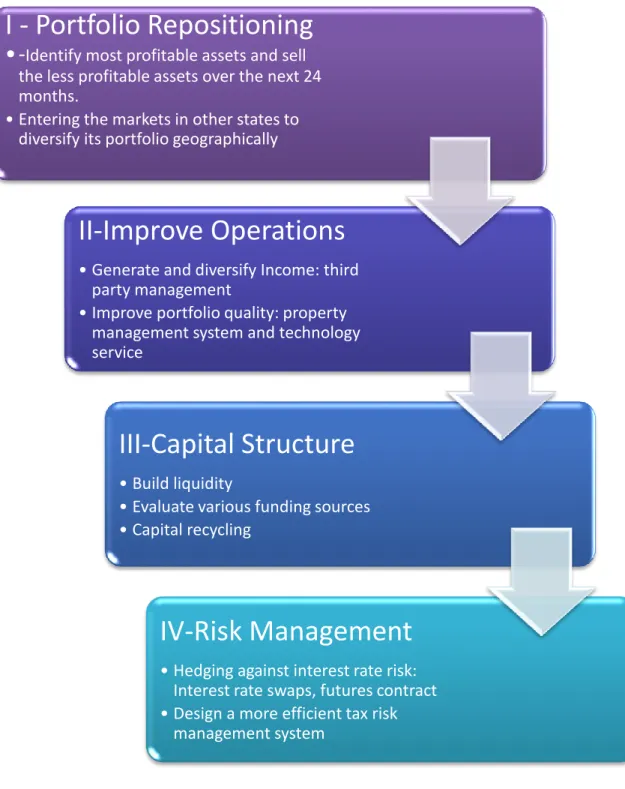A thesis submitted to the faculty of the University of Mississippi in partial fulfillment of the requirements of the Sally McDonnell Barksdale Honors College.
Oxford May 2014
Approved by
Advisor: Professor Victoria Dickinson
Reader: Professor David Nichols
STRATEGIC PLANNING IN REAL ESTATE INVESTMENT TRUST
by Xinyi Long
ii ABSTRACT
XINYI LONG: Strategic Planning in Real Estate Investment Trust
This paper investigates various strategic planning models and then applies the models to the strategic planning process for a Real Estate Investment Trust (REIT). Several strategic models covered in this paper include “Basic” Strategic Planning Model, Issue-Based Strategic Planning Model, Kepner-Tregoe Matrix Model, and the Impact Analysis Model.
Next, I discuss the roles of different functional areas within a REIT with respect to strategic planning. After fully analyzing these strategic models and the roles of various functional areas, I choose a REIT (AmREIT, Inc.) and perform a SWOT analysis to identify four issues facing this REIT. These four issues are diversification vs. focus issue, operational issue, capital structure issue, and risk management issue. I provide further analysis for each issue and incorporate the strategic models in the strategic planning process. Lastly, I develop the strategic solutions for each of the issues based on the analysis.
iii
TABLE OF CONTENTS
LIST OF TABLES AND FIGURES………...………...…..iv
INTRODUCTION………...1
PART I: INTRODUCTION TO STRATEGIC PLANNING STRATEGIC MODELS………..2
PART II: THE ROLE OF DIFFERENT FUNCTIONAL AREAS WITHIN A REIT WITH RESPECT TO STRATEGIES………...15
PART III: A REIT CASE STUDY—STRATEGIC PLANNING IN REITS……….17
CONCLUSION……….………32
BIBLIOGRAPHY………..………...………..33
iv
LIST OF TABLES AND FIGURES
Table 1 Cost/Benefit Analysis for the “Basic” Strategic Planning Model………...4
Table 2 Ranking the Operational Objectives and Assigning Relative Weights...8
Table 3 Determining the Total Weighted Scores………..9
Table 4 Rank the Potential Problems………10
Table 5 Different frameworks to Start the Impact Analysis………12
Table 6 SWOT Analysis for AmREIT, Inc……….…21
Table 7 SWOT Analysis for Issue One: Diversification versus Focus Strategy…23 Table 8 Metrics Used to Choose the Best Market to Expand the Portfolio ……25
Table 9 SWOT Analysis for Issue Two: Operating Issue………....26
Table 10 SWOT Analysis for Issue Three: Capital Structure Issue……….28
Table 11 SWOT Analysis for Issue Four: Risk Management………...…29
Figure 1 Steps of Applying the Issue-Based Strategic Planning Model………….…6
Figure 2 General Requirements to be Qualified as REITs………..….…………19
Figure 3 Summery of Strategies for AmREIT……….….…………31
Introduction
The purpose of this paper is to identify and investigate different strategic planning models and then use the models in strategic planning for Real Estate Investment Trust (REIT).
Corporate strategy, as defined in the McKinsey website, is “Developing a strategic direction, supported by the necessary reallocation of resources and coordinated business unit plans, and designing a sustainable strategy development process.” Prior research indicates that corporate strategy models vary in different industries. However, the general guideline for corporation strategy is to align the corporation’s goals and approaches with its mission and vision. Thus, this paper examines a corporation’s functional areas to determine whether the corporation’s approaches coordinate with its goals and mission. The corporation chosen is a Real Estate Investment Trust (REIT). Four issues in this REIT are identified by using a SWOT analysis. Various analyses are conducted to develop strategic plans for this entity.
2
Part I: Introduction to Strategic planning and Strategic Models
Corporate strategy is a set of actions that enable a company to be worth more than just the sum of its parts. The definition of corporate strategy can be divided into two parts (Raynor, 2007). On the one hand, the most important goal of corporate strategy is to add value to the corporation through creating synergy among different business units or functional areas. On the other hand, corporate strategy involves identifying and managing strategic uncertainty or risk. Briefly, designing corporate strategies means finding a balance point between generating returns and managing uncertainty, since greater return means greater risk.
Strategic planning is not the same to all organizations. Differences of strategic planning process exist in various organizations, including private organizations, public organizations, and not-for-profit organizations. However, the basic underlying methods of strategic planning can be summarized in these three simple questions:
1. Where are we now?
2. Where are we going?
3. How are going to get there?
3
Strategic models generally are developed based on the strategic planning principles to make the decision-making process easier and better. There is no one ideal strategic planning model for each organization. Each organization should select one or several strategic models and modify them to fit the organization’s structures and needs. The following models offer a wide range of models for different types of organizations to choose to develop their own strategic planning process.
General Strategic Models
“Basic” Strategic Planning Model
The “basic” strategic planning model is typically used by organizations that are very small, busy, and haven’t done much strategic planning before (McNamara, 2006). A typical user of this model is nonprofit organization. The organization can try to use this model in the first year, and then modify this model to best suit its needs.
Basic Steps of Applying the “Basic” Strategic Planning Model 1. Identify the organization’s purpose (mission statement).
2. Select the goals the organization must reach if it is to accomplish the mission 3. Identify specific approaches that must be implemented to reach each goal 4. Identify specific action plans to implement each strategy
5. Monitor and update the plan
4 Cost/Benefit Analysis
The following table provides a full cost/benefit analysis for the “basic” strategic planning model (see Table 1).
Table 1 Cost/Benefit Analysis for the “Basic” Strategic Planning Model
Benefit Cost
1) This model is best suited for organizations that do not have much experience for strategic planning.
1) This model may not be used to design specific strategies targeted specific issues in an organization.
2) The strategic plan is easy to design relative to some other models, since the designing process is generally carried out by top-level management.
2) The decision making process generally only involves top management which may make the strategic plan impractical and hard to implement.
3) This model can ensure the strategic plan to align with the organization’s mission.
5
Issue – Based (or Goal –Based) Strategic Planning Model
Organizations that start with the “basic” strategic planning model can use this issue-based model to generate more specific strategies to solve different issues.
Steps of Applying the Issue-Based Strategic Planning Model
The general processes of applying this model often starts with conducting a broad assessment of the external and internal environment of the organization, conducting a strategic analysis (“SWOT” analysis), narrowing down and prioritizing issues, and then developing specific strategies to address the specific issues. The following graph depicts the detailed process of applying the issue-based strategic planning model (see Figure 1).
6
Figure 1 Steps of Applying the Issue-Based Strategic Planning Model 1. External/Internal assessment
to identify "SWOT" (Strengths, Weaknesses, Opportunies, and
Threats
2. Strategic analysis to identify and prioritize
major isssues/goals
3. Design major strategies or programs
to address issues/goals
4. Design/update vission, mission, and values (this step also can be the first step)
5. Establish action plans (objectives, resource needs, roles and responsibilities for
implementation
6. Record issues, goals, strategies/programs, updated
mission and vission, and action plans in a Strategic Plan
document, and attach SWOT, etc.
7. Develop the yearly Operating Plan document (from year one of the multi-year
strategic plan)
8. Develop and authorize budget for year one (allocation of
funds)
9. Conduct the organization's year
one operation
10.
Monitor/review/evalu -ate/update Strategic
Plan document
7 Cost/Benefit Analysis
1. Benefit: This model can be used to identify different issues in an organization and then generate corresponding strategies.
2. Cost: 1) The model may make the organization focus too much on specific issues and forget to look at the big picture. 2) The linear approach of this strategic planning process may underestimate the potential of organizations’ own ability to generate flexible response to the environment.
Kepner-Tregoe Matrix Model
According to the MindToolsClub website, The Kepner-Tregoe strategic model is designed to make the “best possible” choice. In order to make the best possible choice rather than the perfect choice, the decision maker has to bear some risk. One of the critical features of the model is to evaluate various risks in different decisions and try to mitigate the risks.
Steps of Applying the Kepner-Tregoe Model
1. Prepare a decision statement to identify the decision’s key objective, required actions, and desired results.
2. Establish necessary strategic requirements that identify what the decision maker must have in the final decision.
8
3. Establish operational objectives that the decision maker wants to have. Identifying the wants enables the decision maker to rank the alternatives based on which ones satisfy the most, or most important, wants.
4. Identify the restraints that will limit the decision maker’s ability to achieve the wants.
Some typical resource constraints include money, materials, and time.
5. Rank the operational objectives and assign relative weights. For each "want", assign a rating of 1 – 10 based on the degree of importance (See Table 2).
Table 2 Ranking the Operational Objectives and Assigning Relative Weights
Objective Weight
Want 1 8
Want 2 7
Want 3 9
Want 4 10
Source: MindTools.com
6. Generate a list of alternatives.
7. Assign a relative score for each alternative:
First eliminate any alternatives that do not meet the "musts" – these are not worth considering any further.
For the first alternative, go through each objective (want) and rate how well the alternative satisfies it using a 1 – 10 scale.
9
Multiply the weight of the objective by the satisfaction rating to come up with a weighted score for each objective.
Add the weighted scores to determine the total weighted score.
Repeat the process for each alternative. (See Table 3)
Table 3 Determining the Total Weighted Scores Objective Weight Alternative A
Satisfaction Rating
Weighted Score
Want 1 8 4 32
Want 2 7 8 56
Want 3 9 9 81
Want 4 10 7 70
Total Weighted Score of Alternative A 239
Source: MindTools.com
8. From the total weighted score for each alternative, rank the top two or three alternatives.
9. Generate a list of potential problems (adverse effects) for each of the top alternative.
Rank the potential problems for each alternative according to probability and significance. (See Table 4)
10 Table 4 Rank the Potential Problems
Adverse Effect Probability Significance Weighted Score
1 5 9 45
2 3 10 30
3 8 6 48
Adversity Rating for Alternative 1 123
Source: MindTools.com
10. Analyze the alternative ranking and the adversity rating and make a final decision 11. Decide on mitigating actions for the chosen alternative:
Look at each of the adverse effects already identified and generate a list of proactive responses to reduce the probability of each.
Continuously monitor these probabilities and take action as needed.
Impact Analysis
Impact Analysis is an important tool designed to identify the impact and consequences of different changes in an organization, according to the MindToolsClub website. It can be used to evaluate whether a project should be run. Once the decision has been made, impact analysis also helps the decision maker to prepare for and manage any serious issues that may arise.
11 The Challenge of Impact Analysis
The challenge in conducting an Impact Analysis is firstly to capture and structure all the likely consequences of a decision; and then, importantly, to ensure that these are managed appropriately.
Steps of Applying Impact Analysis
1. Prepare for Impact Analysis: Clarify the project or proposed solution within the group.
2. Identify the major areas affected by the decision or project, and think about whom or what it might affect. Different frameworks can be used to start the impact analysis (see Table 5)
12
Table 5 Different frameworks to Start the Impact Analysis a). Organizational
Approach
b). McKinsey 7Ss Approach
c). Tools-Based Approach
Consider the impacts on:
Different departments.
Different business processes.
Different customer groups.
Different groups of people.
Consider the following perspectives within an organization:
Strategy
Structure
Systems
Shared Values
Skills
Styles
Staff
Different tools include:
Risk Analysis
Risk/Impact Probability Charts
Stakeholder Analysis
3. Identify All Areas: For each of the major areas identified, consider all of the various elements that could be affected.
4. Evaluate Impacts: Make an estimate of the size of the impact and the consequences of the decision.
5. Manage the Consequences: Decide whether to want to implement the strategy based on the consequences and costs identified.
If a project has already implemented, several things need to be considered:
13
The actions to take to manage or mitigate these consequences.
How to prepare the people affected so that they'll understand and support change rather than fighting against it.
The contingency strategy needed to manage the situation should the negative consequences arise.
Strategic Models Used in REITs
Following are some common strategic models used in REITs (Parker 33).
Financial strategic model – by seeking capital more often from the market in order to grow, being a strategic model that suits a capital intensive industry such as real estate;
Specialization strategic model – being the choice between sector or geographic specialization and diversification;
Vertical integration strategic model – also known as the development strategy and the funds management strategy, whereby the REIT seeks to control and derive returns from all stages of the real estate lifecycle including land acquisition, real estate development, part or whole transaction into a related fund, ongoing management, leasing and so forth within either the REIT or a related fund;
Economy of scale strategic model – where a REIT seeks to grow larger to benefit from lower operating costs and lower costs of capital, being particularly effective for sector specialized REITs;
14
Branding strategic model – building a brand name recognition and reputation among the REIT’s space using customers, also being particularly effective for sector specialized REITs; and
Power in the space market strategic model – where a REIT uses its size and access to capital to corner a market by concentrating its space ownership within a geographically confined space market and so has market power as the dominant space owner.
15
Part II: The Role of Different Functional Areas within a REIT with Respect to Strategies
The Role of Chief Executive Teams
Internal Roles: Monitoring and Supervising, Policy Making, Past and present oriented, and Future oriented.
External Roles: Compliance roles, Performance roles, Provide accountability, and Strategy formulation (Parker 84)
The Role of Facilities Management Team
The facilities management team is responsible for managing the facilities (such as parking lots) and services (such as air conditioning and security) within the properties. The main goal is to optimize operational efficiency at the individual property level (Parker 252)
The Role of Information Technology
The Information Technology team is responsible for managing a range of external service providers, such as software developers, hardware providers, and recovery specialists. The role of IT includes provision and maintenance of hardware, software, database, security, the REIT website, and telephony (Parker 22).
16
The Role of Fund Management Team
The Fund Management Team manages the various funds in the REIT. The major goal is to optimize the risk-return balance at the fund level. The Fund Management Team is responsible for selecting the investment management style and developing the goal and strategic plan for each of the funds comprising the REIT.
Functions of the role include (Parker 23):
o Business planning for each of the funds o Budgeting and forecasting at the fund level
o Performance measurement and analysis at the fund level o Capital management at the fund level
o Foreign exchange management at the fund level o Distribution management at the fund level
o Relationship management with joint venture partners and co-owners
17
Part III: A REIT Case Study—Strategic Planning in REITs
This section is intended to apply the various strategic models described above to developing strategic plans for a Real Estate Investment Trust (REIT). The major goal is to identify and prioritize four issues facing the REIT and then address these issues with specific strategies. Based on the goal of this case study, the main strategic model used here is the Issue-Based Strategic Planning Model, and various decision making frameworks/models are also incorporated in this case study to facilitate the strategic planning process. This section begins with a general introduction of REIT and the various requirements to be qualified as a REIT. Following the general introduction of REIT is a specific REIT case study.
General Introduction of REITS
What is a REIT?
A REIT is a company created for holding income-producing real estates, mortgage-related assets, or both. One major benefit of REIT is that REIT is a conduit entity, which means that income passes through the REIT and directly goes to the individual investors. Thus,
18
compared to corporation, REIT can help investors avoid double taxation, since income is not taxed on the REIT level but only on the individual level (Chan 11).
Three general types of REITs exist based on the REIT definition: Equity REIT, Mortgage REIT, and Hybrid REIT.
Equity REIT: A REIT that only owns, and usually operates, income-producing real properties, including office and apartment buildings, warehouses, hospitals, shopping centers, hotels, and even timberlands.
Mortgage REIT: A REIT that owns only mortgage-related assets (mortgaged-back securities).
Hybrid REIT: A REIT that owns both real properties and mortgage-related assets.
Requirements to be Qualified as REITs
Various requirements exist for an entity to be qualified as a REIT. These requirements can be divided into the following categories: 1). Organizational Structure, 2). Nature of Assets, 3). Sources of Income, and 4). Distribution of Income (Imperiale 34). The following graph shows these requirements in more details (see Figure 2).
19
Figure 2 General Requirements to be Qualified as REITs
*100 Rule: The entity must have a minimum of 100 shareholders after its first year as a REIT.
*5/50% Rule: The entity must have no more than 50 percent of its shares held by five or fewer individuals during the last half of the taxable year.
Requirements to be qualified as a
REIT
1. Organizational Structure
•As a business trust or corporation
•100, 5/50% rule
2. Nature of Assets
•>=75% are real estate assets, cash, and gov.
securitie
3. Sources of Income
•>=75% income is derived from real estate or real estate-related investments
4. Distrubution of Income
•90% dividend payout ratio
20
A REIT Case Study
The REIT chosen for this case study is AmREIT, Inc. According to AmREIT’s 2013 annual report, AmREIT is a full service, vertically integrated and self-administered REIT that owns, operates, acquires and selectively develops and redevelops primarily neighborhood and community shopping centers located in high-traffic, densely populated, affluent areas with high barriers to entry. The core business of this REIT is holding and operating high quality shopping centers with majority of the portfolio located in Texas and others in Atlanta.
According to the Issue-Based Strategic Planning Model, the first step is to perform an external/internal assessment to identify “SWOT”. After fully analyzing the company’s annual report and the real estate market, I develop the following SWOT analysis for AmREIT (see Table 6).
21 Table 6 SWOT Analysis for AmREIT, Inc.
Strengths Weaknesses
One of the highest quality grocery and drug anchored shopping center portfolios
Focus on owning the best assets in demographically superior sub-markets
Experienced, aligned management team
Strong position in the Texas market
Lack of geographic diversification makes AmREIT particularly susceptible to downturns in the Texas economy
Primary revenues primarily come from its tenants, thus a suspend of rent
payment can destroy AmREIT’s cash flow
AmREIT’s current and future
investments and joint ventures could be adversely affected by their lack of sole decision-making authority
Opportunities Threats
Significant opportunities to add Gross Leasable Areas (GLA) organically through redevelopment and increased density
Has access to a pipeline of controlled acquisition opportunities
Competition with both domestic and foreign investors/institutions when pursuing acquisition and redevelopment opportunities
Interest rate risk
Tax management risk
Potential violation of government regulations may lead to severe penalties and even cancelation of REIT status
Complying with REIT requirements may limit the ability to hedge effectively and may cause AmREIT to incur tax
liabilities.
22
Based on this full SWOT analysis for AmREIT, I have identified and prioritize four issues facing AmREIT. I will give a separate SWOT analysis to analyze each of the issues and then design major strategies to address the issues.
Four Major Issues Facing AmREIT 1. Diversification vs. Focus Issue
The portfolio of AmREIT has too much concentration in the Texas market, thus any downside of economy in Texas can cause severe adverse impact on the AmREIT Company.
2. Operational Issue
AmREIT has lots of potential to improve its operations through pursuing growth opportunities and diversifying its income sources.
3. Capital Structure Issue
AmREIT has the potential to improve its capital structures.
4. Risk Management Issue
Risks involved with AmREIT include interest rate risk and tax risk.
23 Issue One: Diversification vs. Focus Issue
A SWOT analysis is developed to fully analyze issue one. (see Table 7).
Table 7 SWOT Analysis for Issue One: Diversification versus Focus Strategy
Strengths Weaknesses
One of the highest quality grocery and drug anchored shopping center portfolios
Focus on owning the best assets in demographically superior sub- markets
Experienced, aligned management team
Strong position in the Texas market
Lack of geographic diversification makes AmREIT particularly susceptible to downturns in the Texas economy
Opportunities Threats
Current presence in the Atlanta market can lead to more
acquisition opportunities in Atlanta.
Other acquisition opportunities exist in other states.
Competition with both domestic and foreign investors/institutions when pursuing acquisition and
redevelopment opportunities
24 Major Strategies for Issue One
1. Repositioning the Portfolio
a) Utilize AmREIT’s presence in Atlanta to acquire more good quality shopping centers in the Atlanta market.
b) Expand the real estate portfolio to other cities. Based on AmREIT’s 2013 Investors’
Presentation, some metrics for choosing the appropriate locations include:
Demographic purchasing power – average household incomes within a one-mile radius of $100,000 or more, resulting in an affluent population with substantial disposable income;
Density of population – 45,000 or more households within a three-mile radius and additional retail drivers, such as favorable daytime employment population, tourism and regional draws;
Demand for retail space – limited nearby retail properties or land available for the development of new retail properties, providing for favorable retail per capita figures as compared to the national and metropolitan statistical area averages;
Desirability of physical layout – physical attributes that provide the best opportunity for our tenants to attract and serve their target customers;
and
Demarcation advantage – site-specific factors that influence traffic to our properties and require analysis beyond the raw demographic data.
25
These metrics can be summarized using part of the Kepner-Tregoe Model described in Part I of this paper (See Table 8). After evaluating different locations based on this matrix, the location with the highest final total weighted score should be chosen.
Table 8 Metrics Used to Choose the Best Market to Expand the Portfolio
Metrics Weight Location A
Satisfaction Rating
Weighted Score
Density of population 7 6 42
Demarcation advantage 8 4 32
Desirability of physical layout 7 8 56
Demand for retail space 9 9 81
Demographic purchasing power 10 7 70
Total Weighted Score of Location A
281
26 Issue Two: Operational Issue
Firstly, a SWOT analysis is developed for Issue Two (see Table 9).
Table 9 SWOT Analysis for Issue Two: Operating Issue
Strengths Weaknesses
Strong liquidity status
Company’s strategic goals involving continually reducing operational expenses
Experienced management group and well-defined organizational structure
Leadership in several market segment
Lack of flexibility in the company’s portfolio
Highly relying on the Texas real estate economy due to the lack of income diversification.
Opportunities Threats
Potential growth opportunities through diversifying income sources
Rebound of real estate market
Barrier of entering a new market and corresponding expenses
Regulation constrains
27 Major Strategies for Issue Two
1. Internal Growth Through Portfolio Operations
a. AmREIT should continue its internal growth, since it has high quality shopping centers and drug stores with prominent anchor tenants.
b. AmREIT should put more emphasis on growing its small shop tenants, since the quality and location of AmREIT’s real estate drives strength in small shop occupancy.
Seven of AmREIT’s nine anchor leases are top grocers; grocers with average sales approaching $750 / square foot;
Only 13% of annualized base rent is attributable to junior anchor tenancy, with limited exposure to “Big Box” retailers;
Shop space has greater rent expansion potential with shorter duration –currently 90% leased.
2. External Growth in Core Markets
a. AmREIT should diversify its income through growing its third-party management business. AmREIT currently manages four institutional joint ventures and four high net worth advised funds comprising over $425 million in aggregate undepreciated book value.
i. Approximately $175 million (undepreciated book value) of these assets in the Advised Funds meet the quality and demographic profile of AmREIT’s wholly-owned portfolio and represent potential attractive acquisition targets over the next 2-3 years
28
ii. Fee income for AmREIT is about $3.9 million annually, covering more than half of the G&A expense
Issue Three: Capital Structure Issue
Presented below is the SWOT analysis for Issue Three (see Table 10).
Table 10 SWOT Analysis for Issue Three: Capital Structure Issue
Strengths Weaknesses
Assets in hands meet the quality requirements and represent potential attractive acquisition targets over the next 2-3 years
Aggressive acquisition strategic goals might exist in the company that challenge the lowest risk tolerance.
Future potential trends for the acquired capital asset may be a concern
Opportunities Threats
Opportunity to continually recycle capital structure
Acquisition of Woodlake Square in order to build up strategic
advantage over advised funds
Threats from the competitor force in terms of future operation for the acquired assets
Regulation constrain may be considered as well
29 Major Strategies for issues 3
Capital Recycling: Besides having continue access to available capitals from outside resources, AMReit could generate additional capitals by selling selected properties that cannot meet its investment criteria and selectively redeploying capital into high-quality investment, such as shopping centers or other long-tenant investments.
Issue Four: Risk Management
Presented below is the SWOT analysis for Issue Four (see Table 11).
Table 11 SWOT Analysis for Issue Four: Risk Management
Strengths Weaknesses
Minor debt and debt maturity issues comparing to other competitors
Long-term debt helps to increase mitigate interest rate fluctuation issue
Potential risks arise from tax and tax management
Opportunities Threats
Organic incremental growth opportunities
Strong network building upon partners and tenants
Market fluctuation and regulation changes related to the interest rate
Tax risk resulting from tax regulations
30 Major Strategies for Issue Four
Based on the above analysis, two of the major risks for AmREIT are interest rate risk and tax management risk. Interest rate risk is important, because a rising interest rate indicates decreasing business value. Tax management risk is also important, because failure to obey tax rule can result in cancelation of AmREIT’s REIT status, incurring double taxation for the investors.
Two risk management recommendations for AmREIT include:
1. Hedging interest rate risk through buying interest rate swaps and futures contract.
2. Designing a more efficient risk management system based on the analysis of AmREIT’s internal system.
31 Summary of the Strategies for AmREIT
A summary of the strategies for AmREIT is provided in Figure 3.
Figure 3 Summery of Strategies for AmREIT
I - Portfolio Repositioning
• -
Identify most profitable assets and sell the less profitable assets over the next 24 months.• Entering the markets in other states to diversify its portfolio geographically
II-Improve Operations
• Generate and diversify Income: third party management
• Improve portfolio quality: property management system and technology service
III-Capital Structure
• Build liquidity
• Evaluate various funding sources
• Capital recycling
IV-Risk Management
• Hedging against interest rate risk:
Interest rate swaps, futures contract
• Design a more efficient tax risk management system
32
Conclusion
Through writing this paper, I learned about different strategic planning models including the costs and benefits for each model. More importantly, I learned about how to apply these models to a publicly traded company. I chose an equity REIT (Real Estate Investment Trust) and identified four issues facing this REIT using a SWOT analysis. After identifying these four issues, I performed a separate analysis for each of the issues and used the strategic models to develop corresponding strategic plans to address these issues. The strategies I developed include the following aspects: repositioning of the portfolio, improving operation, improving capital structure, and managing the interest rate risk and tax management risk.
33
Bibliography
AmREIT, Inc. 2013 Annual Report. AmREIT, Inc., 2014. Web. 5 April 2014.
Chan, Su Han, John Erickson, and Ko Wang. Real Estate Investment Trust: Structure, Performance, and Investment Opportunities. Oxford University Press, 2003. Print.
Imperiale, Richard. Getting Started in Real Estate Investment Trusts. Hoboken, NJ. John Wiley & Sons, Inc., 2006. Print.
McKinsey&Company. “Corporate Strategy.” Web. 17 April 2014.
McNamara, Carter. 2006. “Basic Overview of Various Strategic Planning Models.” Free Management Library. Web. 25 March 2014.
MindToolsClub. “The Kepner-Tregoe Matrix: Making Unbiased, Risk-assessed Decisions.”
Mind Tools Club. Web. 2 April 2014.
MindToolsClub. “Impact Analysis: Identifying the Full Consequences of Change.” Mind Tools Club. Web. 5 April 2014.
Parker, David. Global Real Estate Investment Trusts: People, Process and Management.
West Susex, UK: John Wiley & Sons, Ltd., 2011. Print.
Raynor, Michael. “What is Corporate Strategy, Really.” Ivey Business Journal. 2007. Web.
25 March 2014.
